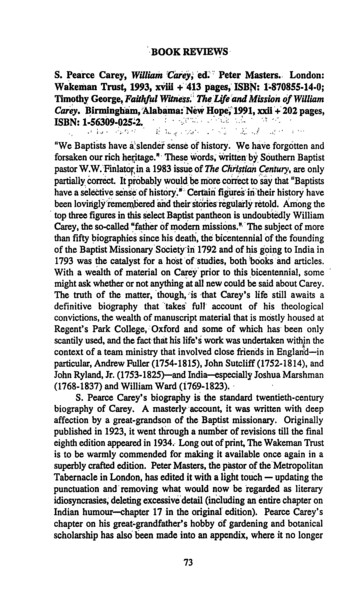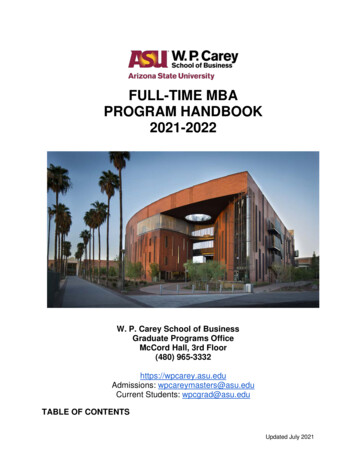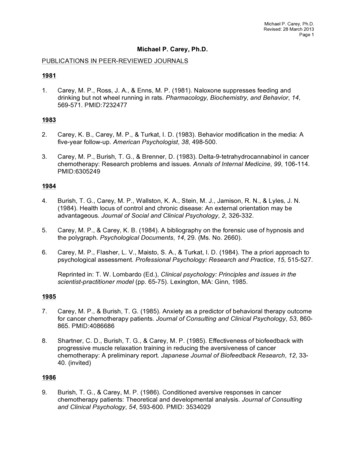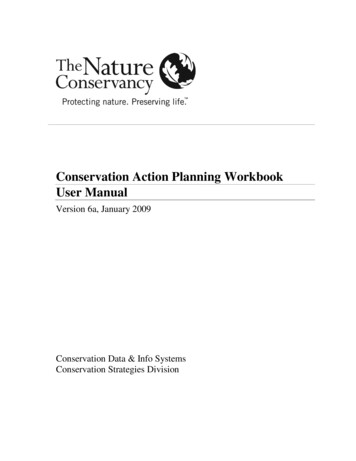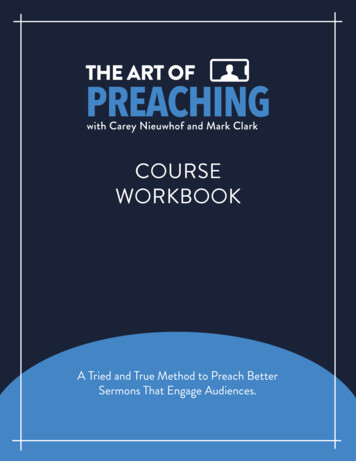
Transcription
COURSEWORKBOOKA Tried and True Method to Preach BetterSermons That Engage Audiences.1 The Art of Preaching Course Workbook
The Art of Preaching with Carey Nieuwhof and Mark Clark.All rights reserved. No part of this publication may be reproduced, distributed, or transmitted in any form or by any means,including photocopying, recording, or other electronic or mechanical methods beyond twelve copies for the sole use of the leadership of the team of the specific church or organization which purchased the course, without the prior written permission of thepublisher, except in the case of brief quotations embodied in critical reviews and certain other noncommercial uses permitted bycopyright law.If you wish for more than twelve leaders in your church or organization to take the course, you may purchase a second copy of thecourse, which contains twelve licenses, or you may contact us at the address below to secure more specific permission based onyour situation. Thank you for respecting intellectual property rights and copyright law.Scripture quotations taken from the New American Standard Bible (NASB),Copyright 1960, 1962, 1963, 1968, 1971, 1972, 1973,1975, 1977, 1995 by The Lockman FoundationUsed by permission. www.Lockman.orgScripture taken from the Holy Bible, NEW INTERNATIONAL VERSION , NIV Copyright 1973, 1978, 1984, 2011 byBiblica, Inc. Used by permission. All rights reserved worldwide. NEW INTERNATIONAL VERSION and NIV are registered trademarks of Biblica, Inc. Use of either trademark for the offering of goods or services requires the prior written consent ofBiblica US, Inc.Scripture quotations marked (NLT) are taken from the Holy Bible, New Living Translation, copyright 1996, 2004, 2015 by Tyndale House Foundation. Used by permission of Tyndale House Publishers, Inc., Carol Stream, Illinois 60188. All rights reserved.Scripture taken from the New King James Version . Copyright 1982 by Thomas Nelson. Used by permission. All rights reserved.For permission requests beyond the terms of this license, please write to the publisher at the address below.Carey Nieuwhof Communications LimitedP.O. Box 160Oro-Medonte ON L0L 2X0www.careynieuwhof.comsupport@careynieuwhof.com 2022 Carey Nieuwhof Communications Limited
CONTENTS04 Introduction07 Session 1: What is Preaching12 Session 2: Preaching to the Unchurched18 Session 3: The How of PreachingSession 4: How to Cultivate Growth and Evangelize ThroughPreaching2327 Session 5: Finding Power in the Text34 Session 6: Creating a Killer Bottom Line44 Session 7: Becoming the Best Preacher You Can Be48 Session 8: How to Deliver a Talk Without Using Notes54 Session 9: Why Your Preaching May Not Be Effective10: Keeping Your Heart and Head Fresh Over the Long58 SessionRun64 Session 11: The Spiritual Dimension of Preaching68 Session 12: Q&A with Carey and Mark
Introduction4 The Art of Preaching Course Workbook
IntroductionWelcome to The Art of Preaching. We’re Carey Nieuwhof and Mark Clark, and combined we have more thanforty years of preaching experience. So we have a few ideas of what to do (and what not to do) when you’re inthis incredibly important role.By the time you’ve completed this course, our hope is that you’ll be an even better preacher than you arenow. These are the principles we’ve used throughout most of our careers, and we believe they’ll connect withyou as well.We’ll cover all kinds of topics in this twelve-session course—everything from preaching without notes andcreating catchy memorable phrases to preaching to the unchurched and staying fresh as a pastor.This workbook is designed as a supplement to the video course. Here, you’ll have summaries of each session,practical applications and exercises, and places to take notes so you can continue your learning. But the meatof this course is the videos. These lessons are dense, informative, and (hopefully!) entertaining, and the videosare where you’ll find the heart of our teaching.As you go through The Art of Preaching, you’ll probably notice that we have different styles. We bothprepare and preach differently—and that’s exactly the way it should be! This course is here to help you honeyour own style, not become a carbon copy of one of us, or another pastor. Use these tools to become themost authentic, real pastor that God has designed you to be.No matter where we are in our pastoral careers, we can all become better at what we do. So we pray thatyou’ll enjoy watching and learning from this series as much as we enjoyed creating it.Let’s get started by busting seven commonly held preaching myths. Watch the video and then tackle somemyths.Myth 1 - Sermons need to be short because people have tiny attention spans.Myth 2 - Clear preaching is watered-down preaching.Myth 3 - You should judge your message based on how well you did.Myth 4 - Biblical preaching doesn’t reach unchurched people.Myth 5 - Topical preaching isn’t faithful preaching.Myth 6 - You should imitate your favorite preacher(s).Myth 7 - Thorough planning eliminates the Holy Spirit.5 The Art of Preaching Course Workbook
Discussion Questions1. Which myths are you most tempted to believe? Why?3. Are there any other myths you believe that you should probably abandon? List them.4. What will you need to do to abandon those myths and embrace what’s true?6 The Art of Preaching Course Workbook
Session 17 The Art of Preaching Course Workbook
What is Preaching?What’s the point of preaching, and how do we define it?The best definition of preaching comes from 1 Corinthians 2:1. Paul calls preaching “proclaiming thetestimony of God” (nasb).Proclaim. That’s a strong word. The church was born out of preaching and proclaiming. The book of Acts hasnineteen sermons. The early church took the gospel from Jerusalem to Rome and it changed the world. Thatdidn’t happen because of soft, uninspired ideas. It happened because people got up and said, “This is howbeautiful God is. You need to reorient your life around this.”The enemy of proclaiming is this idea that preaching is just sharing information. It’s all doctrine and theologyand not heartfelt application. You see, the goal of preaching is more than just information transfer. It’stransformation. Jonathan Edwards said you’ve got to “preach to the affections.”Your job as a pastor isn’t changing what people do, but what people want to do.How do you change their affections, their pleasures, what delights them? You’ve got to preach to the heart.The philosopher James K. A. Smith says people’s biggest motivator in life isn’t what they know. It’s what theyfeel. Statistically, flying is the safest way to travel. But so many of us are frightened to our core of flying in aplane. That’s because our affections, our heart, what we feel, is actually more powerful than logic.Here are three things you can do to make your sermon a proclamation, not just a transfer of information.1. MAKE THE CONTENT LIVEIt’s relevant and contextual. If we’re quoting Matthew 23 and Jesus says you’ve strained out a gnat, swalloweda camel, and you’ve neglected the things of justice, mercy, and faithfulness, then what does that mean to amodern person?Well, maybe it’s the family who spends 15,000 on a trip to Hawaii but doesn’t tithe, give to charity, ordonate to mission work. They’ve neglected the most important things in life. It’s not that going on vacation iswrong. But it’s about finding a way to do both.2. PREACH WITH PASSIONSomeone asked David Hume, a famous atheist, why he was going to watch George Whitfield preach. “You don’tbelieve anything he says,” the person said. “Yeah, but he does,” Hume responded. Something about belief isaddicting.Without passion, it will appear you don’t care about your content. And the gospel is far too beautiful to givesomeone just information.8 The Art of Preaching Course Workbook
3. SPEAK WITH AUTHORITYYou’re not just teaching or suggesting.You’re calling people out of their lives to a new way of thinking. Think about it this way: you’re mobilizing theEnglish language and sending it into battle. That’s a proclamation—making God look so beautiful with yourwords that people are drawn to him.I (Mark) smoked for years. Even as a youth pastor, I would take a smoke behind the building before I went upto preach. I saw all the warnings, the gross teeth and the deteriorated brain pictures that resulted from chainsmoking, but none of that affected me. It was all external.What changed? I met a girl who hated smoking. Eventually, my affections for her outweighed my love ofsmoking. So I stopped smoking. My desires changed.Your job is to get people to realize that Jesus is the only true pleasure and delight, above everything else!Now let’s go back to 1 Corinthians 2. Talking about preaching, Paul says we are “proclaiming.” But what are weproclaiming? He says it’s the testimony of God.So whether you’re a topical or expositional preacher, it all has to be based in the truth of the Bible. When lifefalls apart—when a marriage is gone, a child dies, and tragedy strikes—you’re not going to always be there towalk your church members through the “ways to do X, Y, and Z.” They’ve got to be able to rely on the text.Ephesians 4 says to equip the saints to minister to themselves versus being dependent on you as a preacher.Show them by example that every idea you have comes from the text.That’s what will equip your people to not be dependent on you.Our passion in this course is to employ the best of both worlds: great content and great communication. We’vegot plenty of great communicators who don’t fill their sermons with passion. And we have plenty of preacherswho have the passion but just don’t know how to communicate it.In this course, we’re going to take both of those elements, blend them together, and show the key to going froma good preacher to a great preacher.9 The Art of Preaching Course Workbook
Discussion Questions1. What pitfall do you fall into? The information-transfer teacher type or the preacher typewith great technique but shallower content? Name three adjustments you can make thisweek to balance your content and communication style.2.How can you as a preacher effectively preach to the “affections” and the heart, notjust the mind, without becoming cheesy, shallow, sentimental, emotionally driven, orpredictable? How can you preach to the mind without becoming boring?3. How can you be more winsome and persuasive this week? How can you be profoundlybiblically based so your people aren’t dependent on your personality or charisma this week?10 The Art of Preaching Course Workbook
4. Write down three ways you can start being more intentional about your words. Whatdoes it mean to be “sent into battle” every week versus just “writing a sermon”?11 The Art of Preaching Course Workbook
Session 212 The Art of Preaching Course Workbook
Preaching to the UnchurchedThe ultimate goal of preaching is to reach people with the gospel. That’s why all of us, as preachers, do what wedo.Regardless of your denomination or theology, reaching the unchurched is the inevitable goal of preaching,which is why we call our message the Good News. The gospel isn’t just for us, it’s a message for everyone.There are also more unchurched people in our culture than ever before. So how do you make sure you’respeaking to the unchurched?It’s less complicated than you think. Here are five principles to help you connect with the unchurched.1. PREACH TO PEOPLEIt’s easy to believe that there are churched people issues and issues that unchurched people struggle with. Butwhat if there aren’t churched and unchurched issues? What if there are just people issues? This is an insight I(Carey) picked up from Andy Stanley.Think about it: for the most part, people all deal with the same issues. Self-esteem and insecurity are challengesfor the churched and unchurched alike. Everyone has relational problems, doubts, anger, and stress. Researchsays 70 percent of people don’t like their job—another issue that impacts both Christians and non-Christians.So how do you connect with both the churched and unchurched? Focus on people issues. Get inside the head ofthe average person and figure out what they’re thinking about before they even come into the room, speak intothat issue, and you’ll have an attentive congregation whether people have a church background or not.2. MEET PEOPLE WHERE THEY ARE ATSo how exactly do you know what the average person is thinking when they come into your building? Wisepreachers learn how to identify the common struggles everyone deals with—marital issues, career problems,and the normal worries, doubts, and anxieties of life. You can study culture and study people to identify those.Not surprisingly, the problems we face aren’t just our generation’s issues. Most of our struggles have beenaround for thousands of years. The Scripture is filled with life challenges people have faced since the beginningof time. What people in our church today struggle with is the same stuff David and Peter dealt with. Peopleissues have existed as long as people have existed.How do you know if it’s an issue you should address? Well, here’s a shortcut. If you struggle with it, then theyprobably struggle with it too. Wise leaders realize that most of the issues they’re struggling with personally areissues people face at one time or another.So speak out of your struggle. This forces you to be a bit vulnerable as a preacher, but people will applaud yourauthenticity when you talk about your imperfections. After all, people admire your strengths, but they resonate withyour weaknesses.13 The Art of Preaching Course Workbook
Think about it. If all you ever say is, “My wife and I are doing great,” they’re probably thinking, “Okay. Good foryou.”But if you tell a story about a fight you and your wife had at Costco (with her permission, of course), and youplay out the scene for them, people are going to lean in and listen. They’re going to think, “You’re just like me.”And the truth is, you are.This is so important. Even as a preacher, you never want to appear like you have it all together, because youdon’t. None of us do. The church needs to feel like you’re in this together, trying to figure it all out.If you can assume this posture, you’ll discover that people can deeply identify with what you’re saying.3. ASSUME INTELLIGENCE, NOT BACKGROUNDGreat communicators assume their audience is intelligent, but they also realize that their listeners might nothave a deep knowledge or even any knowledge about Christianity. There’s a critical difference between assumingsomeone is stupid and assuming someone doesn’t have the same background.So how do you demonstrate sensitivity to a lack of background? First, guard against “Christianese”—thatlanguage we only use in church that makes no sense to anyone who doesn’t go to church. Every preacher shouldeliminate insider language. And let’s be honest—as Christians, we get weird sometimes, using phrases that don’tmake any sense to anyone else. Every time we do this, we alienate the unchurched.How should you speak? Imagine you’re having a cup of coffee with your audience (one-on-one) or chatting withthem at their home. Ask yourself what type of language you would use. If it’s not how you talk normally, thendon’t use that language in the pulpit. Speak clearly and plainly, like you would in normal conversation.Preachers should also master the ability to speak with minimal assumptions. Become a master at bringing peopleup to speed on the biblical background of a passage or character in sixty seconds or less. If you’re talking aboutKing David, avoid saying, “As we all know, King David ” because, frankly, they don’t all know. Instead, do a twoto five-sentence summary of who David is and how he fits into the story you’re about to tell.Eliminate insider language and become a master at bringing people up to speed quickly, and you’ll help intelligentpeople stay engaged and find the background to the biblical story.4. DELIVER WHAT PEOPLE NEED TO HEAR IN A WAY THEY WANT TO HEAR ITThere’s a debate in church circles about whether you should preach what people need to hear or what peoplewant to hear. The best preachers deliver what people need to hear in a way they want to hear it. You can dothat without compromising your theological integrity one bit. In fact, you’ll enhance it because you’ll have anaudience ready to hear the gospel.This isn’t a matter of preaching what people’s “itching ears” want to hear; it’s a matter of delivering timelesstruth to them in a way they can hear it.Here’s an example: I wanted to do a biblical series on fear. I wanted to call it “Scared to Death.” I thought it wasa really great phrase that people would resonate with. However, as our team talked about it, we realized that,while fear is a topic a lot of men struggle with, many men don’t want to admit they’re afraid.14 The Art of Preaching Course Workbook
In discussing this, we agreed that fear can be broken down into four major struggles: fear, depression, anxiety,and stress.We researched and learned that men were much more okay with the terms stress and anxiety than they werewith depression and fear.So we changed our approach. We decided to deliver what people needed to hear in a way they were more likelyto hear it. We ended up calling the series “Stress[Less].” Because most guys are okay saying, “I’m so stressed atwork,” or even admitting to struggling with anxiety.Our theology didn’t change. God is the answer to our fears, but we positioned the series in such a way thatpeople would want to hear it.I’ve also done a series on idolatry. We didn’t name it “Burn Your Idols” or “Idol Worship 101.” Instead,we cashed in on a cultural trend and called the series “Selfie.” People could easily understand that.It was yet another way for people to hear what they needed to hear in a way they wanted to hear it.5. START AND END WITH APPLICATIONFinally, it’s critical in preaching to the unchurched that you emphasize application, because applicationestablishes relevance to the churched and unchurched alike. How much application, you ask? Well, Rick Warrenwas once asked what the key to a great sermon is. His response: “Application, application, application. Beginwith application, put application in the middle, and end with application.”How do you do that? Well, you establish the why behind the what, walk people through specific scenarios, andtake time to give specific examples and stories from your own life. Make sure you include details in the storiesyou tell.For example, instead of talking about “this guy at work who is annoying,” get into the details. Talk about how youarrive at work, put your lunch in the fridge, and sit down next to your desk mate. Explain that his chair squeaks,he moves all the time, you don’t think he’s showered, and he talks so loudly.That’s a word picture your audience can relate to. It conjurs up far more emotion that when you just say thatsome guy is annoying.These five principles will help you better connect with people from every background and help you bridge thegap between preaching to the churched and to the unchurched.These practices make take years to develop and hone. Be patient, but be persistent. I still don’t have it downperfectly. But if you’ll start following these five principles, you’ll be able to better connect with unchurchedpeople.15 The Art of Preaching Course Workbook
Discussion Questions1. Which of the five principles do you currently utilize at some level? Which are new toyou?2. Make a list of 10–15 life issues that you or someone you know struggles with (i.e.marriage tension, financial pressure). Refer back to this list to create future sermonillustrations and examples:3. List at least five past or current struggles you’ve lived through that you can share infuture messages:16 The Art of Preaching Course Workbook
4. List 3–5 biblical issues people need to hear about and then figure out a correspondingfelt need you can address. This will help you figure out a way for people to hear what theyneed to hear in a way they want to hear it.5. Write a story about a dad who’s frustrated with his young son in a grocery store. Practicesharing details, emotion, and nuance so the story comes to life.17 The Art of Preaching Course Workbook
Session 318 The Art of Preaching Course Workbook
The How of PreachingOne of the most effective ways to go from being a good preacher to a great preacher is by simply understandingwho you are.Who are you as a person? What is your past and your experience?I (Mark) grew up in a skeptical, unchurched background. My parents divorced when I was nine, and I developedTourette’s Syndrome and Obsessive Compulsive Disorder. So, literally, as a kid I would just randomly swear atpeople. I’d be sitting at a bus stop and just yell out the f-bomb.Maybe not a good habit for a preacher, right? This is the last job you’ll ever get if you’re randomly yelling cursewords in public. So it’s very odd that this is the role I’m in many years later. But here’s the reality of my situation.God uses us not because of us, but in spite of us.Don’t be ashamed of how God has wired you. We’ve all had disadvantages in some way. It’s just a matter ofrealizing God will use that crucible in your life to create a resurrection. God will use you not because you’regreat, but because he’s great.Here’s another way to become a more effective preacher: Pick a text and pick a target.Your message, whether you’re a topical or exegetical preacher, must be based in the Bible. That’s the authority.With that, you’ll have different messages for different audiences.I was speaking at a pastor’s conference one time, and the organizers asked me to stay deeply theological andvery “lecturish.” When I got there, I realized the attendees were broken pastors looking for peace, not someacademic lesson. So I changed everything. I based my message on my target audience.Think about the Prodigal Son parable. Tim Keller talks about the idea that our audience in church should alwaysbe the older brother and the younger brother. The older brother is religious. He knows all the right things anddoes all the right things. Then you have the younger brother who’s a disaster. He spends all his dad’s money,sleeps with prostitutes, and his life is a train wreck. Every sermon you preach should be focused on both of theseaudiences.The bottom line: Discipleship and evangelism can happen at the same time. They can happen every week,every sermon, every moment.Here’s another way to know yourself better and improve your effectiveness: Find the best process.Every pastor has a different process. But people ask me about my process all the time, so let’s walk through it.19 The Art of Preaching Course Workbook
On Monday, I start reading commentaries in the evening, maybe underlining with a pen in the living room whilethe kids are watching TV. I read a lot of commentaries Monday through Wednesday. Then I block off everyThursday at noon until Friday at 5 p.m. for sermon prep.During that time, I take all the notes from my commentaries and write them all out. Usually I’ll take twelvepages or so home with me on Friday evening. I spend Saturday with my family. At about 5 p.m. on Saturday, Isay goodbye to my family and take those twelve pages and cut them down to five. I cut the boring stuff, read,and say everything out loud.At about eight or nine on Saturday night, I put everything on my iPad and mark it up. I circle keywords andhighlight stories. Then I get up at 5 a.m. on Sunday and study for another two hours. By the time I’m in thepulpit, the notes are like a Linus blanket—I know them all front and back, but they’re there for backup. As Careysays, it’s all about understanding your talk instead of memorizing your talk. And I believe my process has helpedme do just that.Get to know what works for you in a weekly process. Your free time will feel more free and your work time willbe more productive.20 The Art of Preaching Course Workbook
Discussion Questions1. How has God wired you and led your life that makes you unique as a preacher? How canyou leverage your unique story to connect to your audience as a communicator? Whatabout your life could people identify with?2. How can you make sure you’re doing exegesis, not eisegesis, in your preaching? (Alwayslet the text lead you where you go.)3. How can you make sure you’re speaking to both the older brother and the youngerbrother in every sermon? Which one do you need to speak to more? (Take it a step further:Ask this question of three people in your church who aren’t your friends or family.)21 The Art of Preaching Course Workbook
4. What changes could you make in your preparation process to help make you great?Evaluate your week. Do you work hard and smart on your sermons?22 The Art of Preaching Course Workbook
Session 423 The Art of Preaching Course Workbook
How to Cultivate Growth and EvangelizeThrough PreachingIn the last session, we focused on the importance of both discipleship and evangelism. That was Jesus’ call and,as preachers, it’s our call as well.Let’s dig in a little on the evangelism side of things in this session. How can you practically cultivate evangelismin your church? Here are six ways.1. YOU NEED TO BE CONVINCED THAT EVANGELISM IS CORE TO YOUR CULTURE AND DNA ASA CHURCHThat will filter down from the pulpit to the pew. If you never tell stories about neighbors who are coming to knowJesus, that will reflect in your church.If you represent someone who seeks and saves the lost—not only in your messaging but also in your life—thenyou’ll have a group of people who are on mission with you.2. FOCUS ON WHO IS PREACHINGIf you’re their leader, they want to hear from you. Not every sermon will be a perfect ten, and some weeks youmay feel unprepared, but there’s something about that consistency every week.Of course, team preaching is great. But everyone has to have the same DNA and point the same way in theirmessaging. If not, your church will have a scattered focus. So use those teaching pastors and campus pastors topreach and teach. But the presence of the lead pastor is vital to creating an evangelistic spirit in your church.3. YOU NEED TO MAKE SENSEWell, of course.But think about it this way: When you’re prepping, don’t just think about “church Joe” who is always there.Think about your skeptical brother-in-law or that unchurched person you know. What would they think of thismessage?Take John 1 for example. He says, “In the beginning was the Word ” Your unchurched brother-in-law would belike, “What does that even mean? The word?” You’ve got to explain that in a way that makes sense.4. YOU’VE GOT TO TALK ABOUT SINYou have to be real with people. You can’t avoid talking about sin.If you don’t tell people what their situation is, they’re not going to understand what they’re being saved from.24 The Art of Preaching Course Workbook
Martin Lloyd Jones once told me, “There are many people who preach about the Lord Jesus to no effect, andwe can see why. They have no doctrine of sin, and they never convict or convince people of sin.” His point is thatyou have to actually tell people their plight. You have to show them their scenario and show why Christ actuallycame and did what he did.So you’re constantly dialoguing with that skeptic in your head. You’re constantly looking at the biblical textthrough their eyes, and you’re not afraid of telling them their plight.5. LEVERAGE THE RHYTHMS OF THE CULTURAL CALENDAROur church has two massive attendance points each year on Christmas and Easter, as yours probably does too.Attendance doubles during those weeks.Do you leverage those opportunities?I try and catch people off guard. They have expectations on those days, and I try to really step on thoseexpectations.I might say something like, “Why are you here? Because this day is either the dumbest day and a joke—and youshouldn’t pay any attention to it or show up next year—or it’s the most important thing that has ever happenedand you need to rearrange your entire life around it.” Then I build on that throughout the sermon.Or we might have a series that comes out of that idea—something like “The Top Three Questions about Jesus.”New people have shown up, and we want them to actually know Jesus. So we invite them into an ongoingconversation.Don’t waste these opportunities. Catch them off guard.5. EQUIP THE SAINTS TO BE GOOD EVANGELISTSIf your whole church looks to you to be their evangelist, then your ministry is going to orbit around you.But imagine if all your church members were evangelists because you modeled evangelism in your preaching.Whether they’re soccer moms or CEOs, they’re becoming equipped to talk about the gospel and lead peopleto Jesus.Imagine if people were coming to know the Lord on a Tuesday afternoon over coffee, or on a Thursday eveningat a small group, and it didn’t depend on you. They didn’t just bring someone to you and let you explain it.They’ve learned what evangelism looks like from you, and now they’re equipped to pass it on.So your job is to equip your entire church to be evangelists. Then you’ll see growth because they’ll be out takingwhat they’ve learned from you and doing ministry on their own.Growth won’t happen overnight, but a culture based on evangelism will eventually bring more and more peoplethrough your doors.25 The Art of Preaching Course Workbook
Discussion Questions1. Out of the six things we explored, what are two you could work on this year?2. How can you start speaking directly to unchurched people in a dialogical way in yoursermons this week? A key way is to read some skeptical books: The God Delusion (RichardDawkins) and God Is Not Great (Christopher Hitchens) are a great start!3. What can you do this quarter at your church to equip your people for the work
Myth 2 - Clear preaching is watered-down preaching. Myth 3 - You should judge your message based on how well you did. Myth 4 - Biblical preaching doesn't reach unchurched people. Myth 5 - Topical preaching isn't faithful preaching. Myth 6 - You should imitate your favorite preacher(s). Myth 7 - Thorough planning eliminates the Holy Spirit.
![Welcome [carey.jhu.edu]](/img/15/gmba-welcome-packet-class-2020.jpg)
